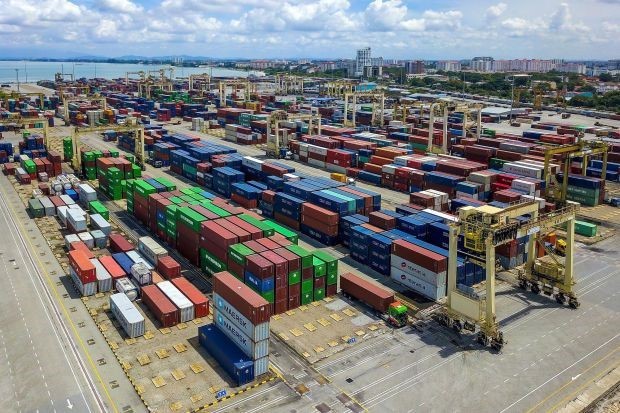
Image credit: The Star
PETALING JAYA: Malaysia’s trade momentum is expected to be robust with economists projecting exports growth at 9.2% to 10% this year.
Amid some headwinds, they noted that exports would be driven by electrical and electronics (E&E) and commodity-based products. Bank Negara has forecast exports rising by 10.9% this year.
RAM Rating Services Bhd economist Nadia Mazlan expected exports to remain strongdue to the high commodity prices as well as ongoing semiconductor supercycle.
The higher prices of crude oil and crude palm oil will likely lend support to exports in the short term, offsetting some of the slower demand arising from the continued supply chain issues.
“Export activity will also expand as E&E exporters continue to fulfil backlogged orders,” she told StarBiz.
In March, E&E exports surged 32.8% year-on-year (y-o-y) leading to a stronger-than-expected total export growth of 25.4% y-o-y, double that of the Reuters consensus of 12.5%.
Imports would move in tandem with export performance, largely supported by the demand for intermediate parts and supplies to fulfill export orders, particularly for E&E goods, she added.
However, Nadia said while exports and imports would remain strong this year, growth would likely moderate this year due to the high base in 2021 as well as dampening demand arising from the Russia-Ukraine war.
Bank Islam (M) Bhd chief economist Mohd Afzanizam Abdul Rashid, who is forecasting a 10% growth for exports this year, expected export growth be driven by E&E products and commodity-based products this year.
He said: “The proliferation of technology will continue and this will effectively create demand for microchips that will involve integrated circuits and parts. This will also benefit the nation’s oil and gas (O&G) and plantation sector exports. In a way, Malaysia is in a sweet spot.”
OCBC Bank economist Wellian Wiranto said domestic exports would broadly benefit from the twin engines of commodities and semiconductor demand.
However, he said the pace of growth may be curtailed compared with last year given the spectre of slowing demand in major economies, as illustrated by the considerable downgrade of global growth forecast by the International Monetary Fund (IMF (IMF) recently.
“Lingering labour shortage issues that affect corners of Malaysia’s production, including palm oil, for example, may act as hindrance to further upticks in exports growth this year,” Wellian added. OCBC Bank is projecting exports to grow by 10% this year.
IMF has trimmed its global growth forecast to 4.4% from 4.9% for this year due to increasing uncertainty in global demand. Global growth was 5.9% in 2021.
In March, higher commodity prices had led exports to expand for the second straight month, surpassing market expectations.
Exports grew by 25.4% y-o-y to a record level of RM131.64bil. The market had predicted a growth of 10.4%.
Meanwhile, the country’s imports also grew by 29.9% y-o-y to an all-time high of RM104.93bil. Following the higher exports value than imports, Malaysia’s trade surplus widened to RM26.7bil, 10.3% higher than a year ago.
Domestic exports were valued at RM106.9bil, contributing 81.2% to total exports, picking up strongly 22.8% y-o-y. Re-exports amounted to RM24.7bil, expanding by 38% as compared to March 2021.
MIDF Research said the continued expansion in global demand for E &E and commodities would support the overall export outlook. Moreover, the reopening of economies will facilitate growing trade activity this year, it added.
With concerns over the near-term outlook, MIDF Research has maintained its growth forecast for exports and imports at 7.8% and 9.6%, respectively, for 2022.
TA Research said Malaysia’s trade sector would continue to grow this year.
“While the moderation in external trade has been in line with our expectations, the pace of growth for both exports and imports has been stronger than our projections.
“As a result, we have revised our growth projection higher for both exports and imports to 9.2% y-o-y and 9.9% y-o-y, respectively,” it said.
Commenting on the headwinds which would impact export growth, Nadia said given the country’s limited direct trade links with Russia and Ukraine, the repercussions of the conflict would materialise in Malaysia mostly through second order effects.
The ensuing supply chain disruptions and surge in inflation from sanctions against Russia would dampen global economic growth and in turn impact export demand.
“Thus, if the magnitude of the war’s impact on Malaysia’s key trading partners is sizable, this could significantly slow down exports.
“The prolonged lockdowns in China amid its zero-Covid-19 policy also risk worsening supply chain disruptions. As the world’s largest exporter, a slowdown in Chinese trade would have a ripple effect on global trade and subsequently Malaysian trade activity,” Nadia noted.Sharing a similar view, Bank Islam’s Afzanizam said the disruption in the global supply chain would be one of the key downside risks.
“The zero-Covid strategy implemented in China has a serious implication, especially in areas relating to ports like Shanghai, Ningbo-Zhousan, Shenzhen, Guangzhou and Qingdao.
“We know that Shanghai is the busiest port in the world and given the close linkages of China’s economy with the rest of the countries globally, it could potentially delay production activities,” he added.
Source: https://www.thestar.com.my/business/business-news/2022/04/25/robust-trade-momentum-seen-exports-up-10

